Rice Harvesting
September 29, 2014
 | We traveled to Brent's ricefields just east of Amagon on Hwy 14. This was one of the two fields that we hoped to harvest today. |
I rode with Brent out to the grain bins east of Newport where they were hauling the rice, and I drove Brent's pickup to the field so he could bring one of the big grain trucks to the field. On the way we drove by fields that they had previously combined. | 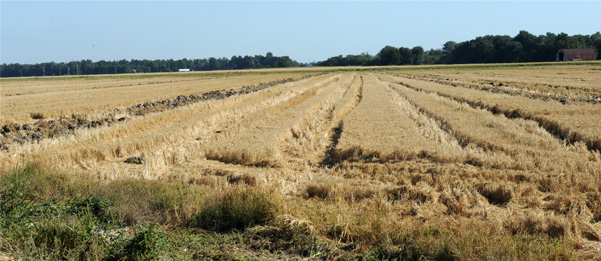 |
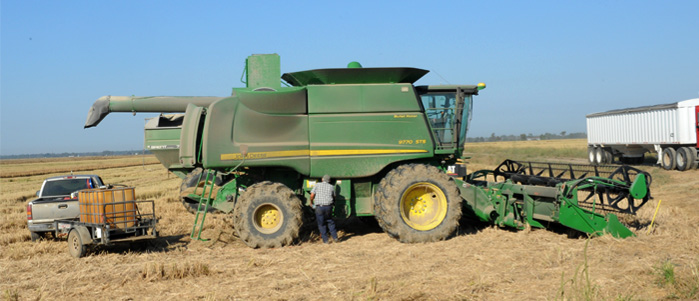 | Bobby had driven to the field earlier and was servicing the combine. One of the large grain trucks is sitting to the right. |
Brent and Bobby went through a maintenance sequence of checking oil and grease in axles and other drive shafts. | 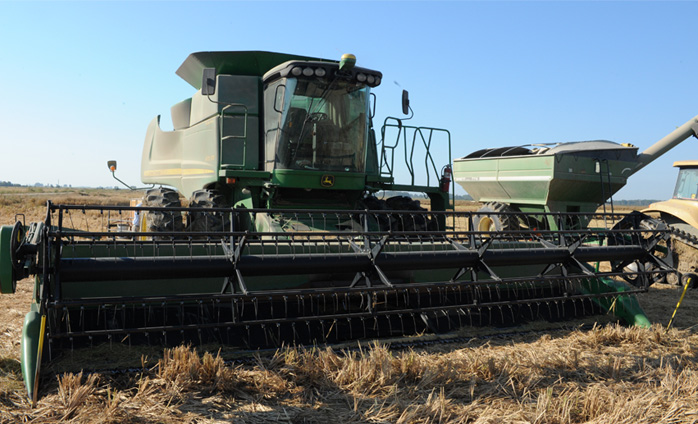 |
 | This track-driven tractor was used to pull the grain buggy for grain transfer from the combine. I had never been around such a tractor. |
All this heavy machinery and human effort to do a clean extraction of these grains of rice. | 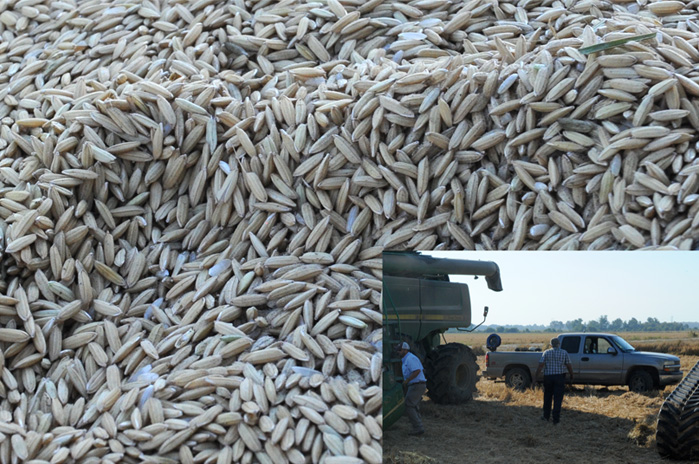 |
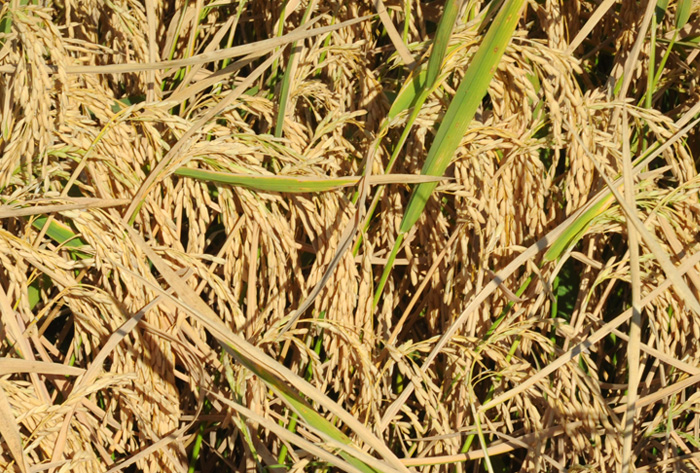 | But this extraction was by no means a simple process, because the golden rice grains were mixed in a heavy canopy of blades and stalks. The combine process is an amazing piece of technology. |
| The last step in preparation was a trip back to the grain bins with Bobby to pick up a third truck. This was a local person with whom Brent had done business, and it gave them a shorter distance to haul the rice. | 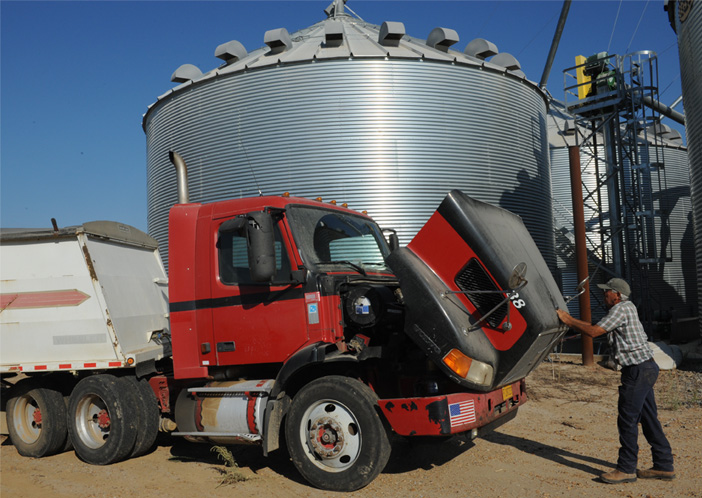 |
 | Now with three big grain trucks lined up and waiting, they were ready to start combining. One truck had been left in the field Saturday and Brent drove one in this morning. |
Brent is off down the rice field with the combine, cutting a 25-foot swath of the heavily laden rice. |  |
 | Bobby and I took off after him with the tracked vehicle and the grain buggy. Their usual driver was off for an appointment, so Bobby was patiently teaching me how to control this vehicle. |
We got a couple of buggy loads and emptied them into the first truck, but then we saw Brent pull the combine back into our initial maintenance location. He had gotten a major jam and this sophisticated machine had ground to a halt. After panels were removed, this is a view of the innards of the machine. |  |
After intake from the 25-foot cutter, the rice travels through a cylinder called a bullet. In a process that still seems slightly magical to me, it strips off the grain and ejects the straw and grassy residue. But at the end of the bullet, it passes through a comparatively narrow slot, and there it had gotten solidly jammed so that Brent couldn't budge the straw through the slot. All three of us worked for over two hours on unjamming it. With a lot of force jamming it, the material was so tightly packed that we had to unbolt the metal plate just above the big pulley center right. With a big pipe wrench and all the pry bars we could find, we worked on getting the tight material out to the point where we could turn the pulley with wrenches and levers. After getting it to the point where the pulley would turn, they tentatively rebolted the plate and Brent cranked up the combine to see if it would clear. To our great relief, it promptly regurgitated all the remaining material into a pile behind the machine. So we were ready to go again.
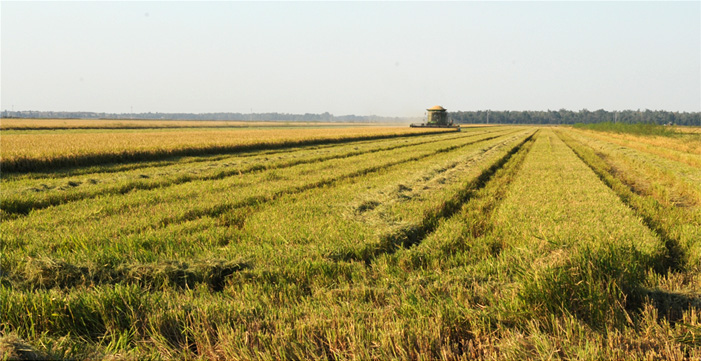 | Brent was back in the field with the combine! Happily, it performed beautifully the rest of the day. Note that it cuts the stalks fairly high, just under the rice-bearing heads, so that it doesn't have to process the volume of the entire stalks. |
With Bobby riding with me as coach, I made a number of loops to load rice from the combine and to bring it to the truck for unloading to the big trucks. The auger on the buggy was powered by the tractor to feed the grain into the truck. It took some practice for me to position the buggy under the chute from the combine for the transfer of the rice, and then to position the chute from the buggy over the truck for unloading to the truck. But this was the third truckload, so we brought in a lot of rice. |  |
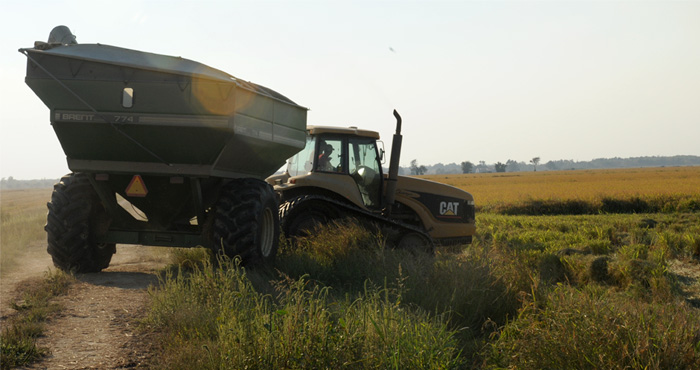 | After unloading the buggy to the truck, we would head back to the field to catch up with the combine. |
As a rookie buggy driver, I took a good bit of ribbing about one of my levee crossings. Brent had crossed the levee to the next section of the field, and I headed out after him - but crossing the levee with this tracked vehicle was very different from Brent crossing it with the big rubber tires of the combine. As I approached the levee, Bobby yelled "No, No! The levee!" But it was too late. The front of the track rared up, and as it passed the center of gravity it tilted down like a see-saw, launching me and Bobby to the ceiling of the tractor cab. He got a crick in his neck, and I wore a red bruise on the top of my head for a few days as if Brenda had clobbered me with a skillet. But I learned not to do that again! | 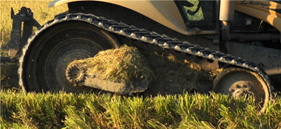 |
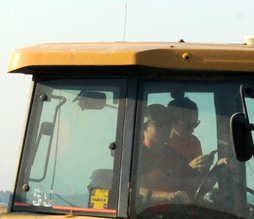 | So I learned to follow Brent and advance under the grain chute when he swung it out. The first couple of times he stopped to make my positioning easier, but then he would keep moving at about 2 mph as I positioned under the chute so that he could continue to combine while the auger unloaded the hopper into the buggy. I would continue to follow for a second hopper dump and then circle to the trucks. After a while, Bobby left me to solo while he drove a truck of rice to the storage bin. I had about filled the third truck when Garrett and Megan arrived and I turned over the buggy driving to him with Megan as copilot. |
With Garrett's experience in the field, the process could now speed up, and he took off to catch up with Brent. | 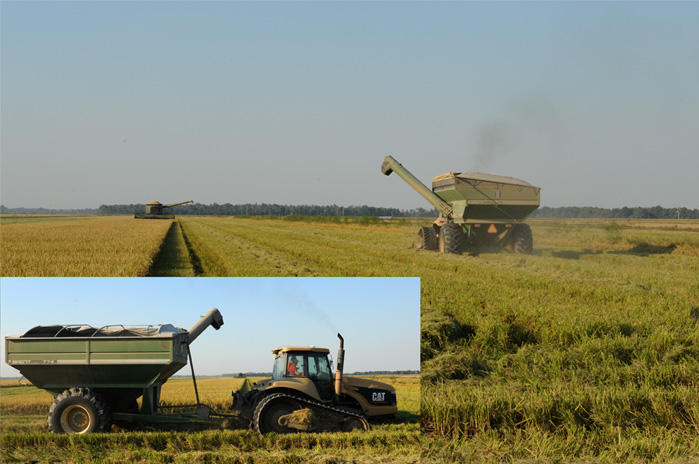 |
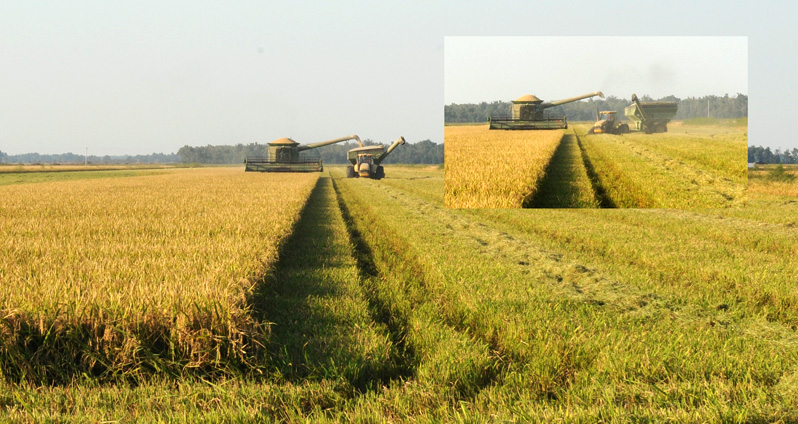
Garrett zipped down the field and expertly positioned the buggy under the grain chute while Brent kept trucking down the field.

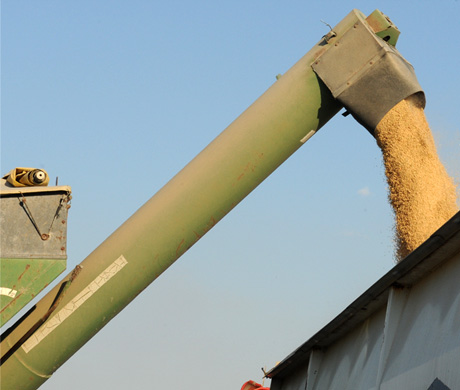 | Garrett moves to unload the rice to the truck, and I got an external view of what I had been doing all afternoon. The cleanness of the rice is impressive after what I had seen of the messy interior of the great machine. With Bobby's coaching, I had learned to position the chute over the center of the truck, and how to move along that center as the rice piled to the the point where you could see the peak. Even with the tractor in neutral and the brake on, turning the steering wheel would reposition the chute since the tracks were always active. Turning the wheel would cause one track to advance and the other to retreat to turn the vehicle, and also the buggy since it was hitched to the tractor. After I got used to it, it was an advantage, because you could turn the steering wheel to fine tune the position of the chute side-to-side. Since the grain auger was driven by the power-takeoff of the tractor, you could speed up the auger by turning up the throttle. |
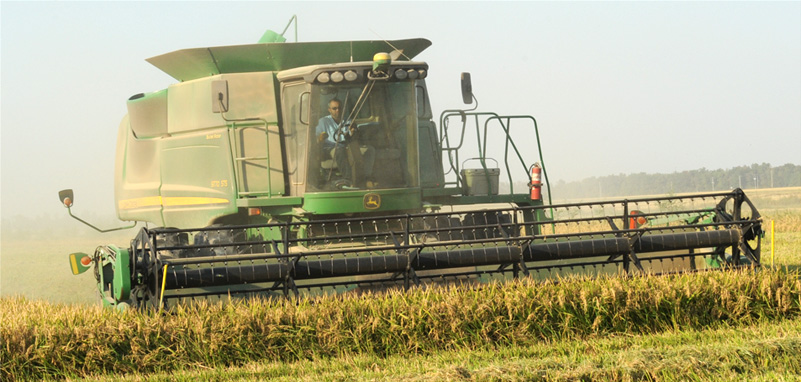
Sitting high in his cockpit, Brent brings the combine to the near end of the field. He invited me onboard, so this was my first time to ride a combine. Pretty impressive machine with led readouts of moisture content, average yield per acre, and lots of other numbers. It also beeped when he needed to unload the hopper. On his handle for speed control was a control panel to operate the boom for grain unloading, the position and angles of the frontend, etc. Later, as I was riding with him, I could watch the projected yield change in different parts of the field. One of his comments on a low yielding area was that it was "cold water rice", near the pumps where the water straight out of the ground hadn't warmed up yet. It was news to me that the temperature of the irrigation water could have a significant effect on the yield. | 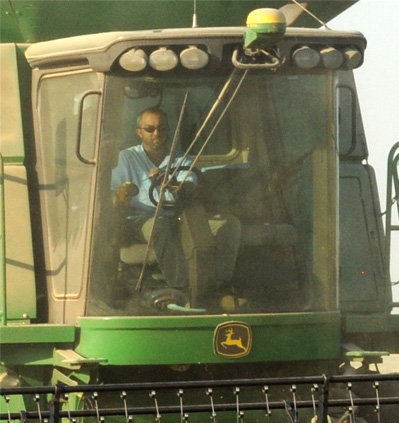 |
 | A still picture can't do justice to the view from the cockpit. At the bottom of the picture you can see the blades, and this 25-foot row of blades oscillated back and forth, cleanly cutting the rice just below the grain heads. Then it was funneled into the center opening for processing. |
Brent swings his boom out with a flick of his thumb on the control stick, and Garrett and Megan pull up under the boom and travel along with us while the rice unloads into the buggy. | 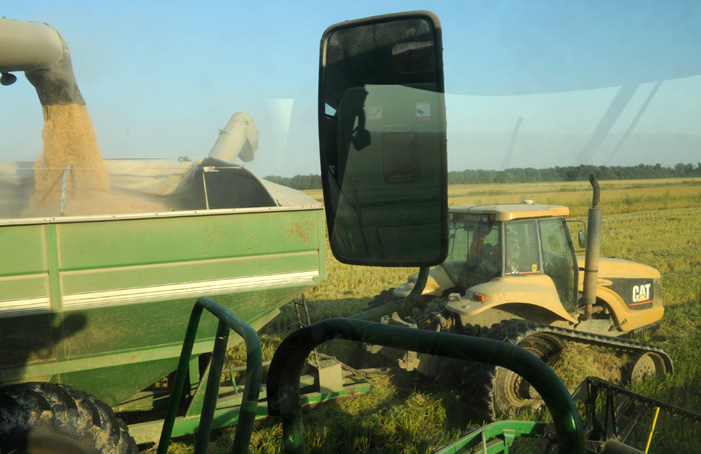 |
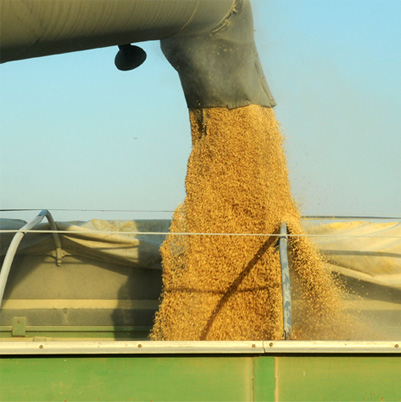 | 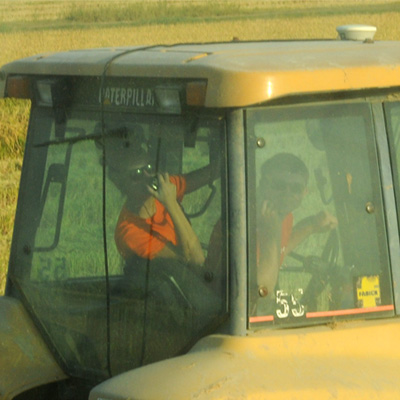 |
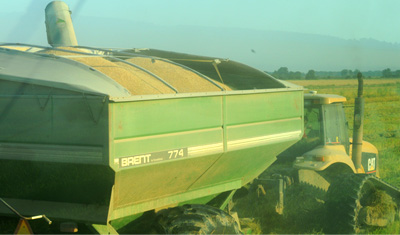 | 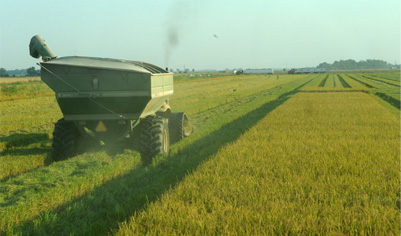 |
With buggy full, they head out for the trucks at the end of the field.
 |  |
An exercise in practical design here. In an area of a lot of down rice, the tines on the front rotating spindle lifted the down rice so that it was cut and entered the combine. The image at right above was on the next pass, and shows that very little rice was left on the ground. After looking at that matted rice lying on the ground as we approached it, it was hard to believe that it had been picked up and cut so cleanly.
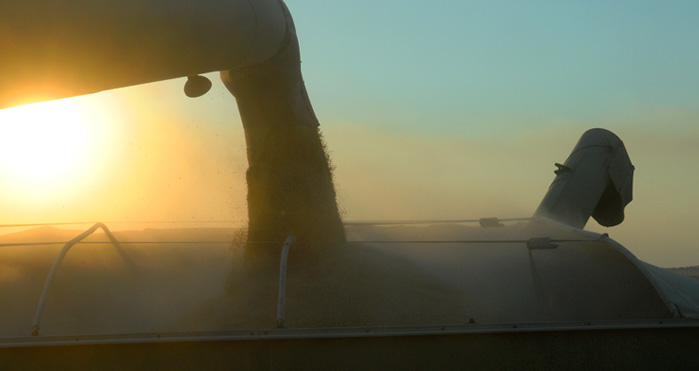 | As sunset approached, Brent was still pouring rice into the buggy. |
| Bobby pulls a truck back into line after a load to the storage bin, and Brent parks the combine as we call it a day. It certainly was a learning experience for me. | 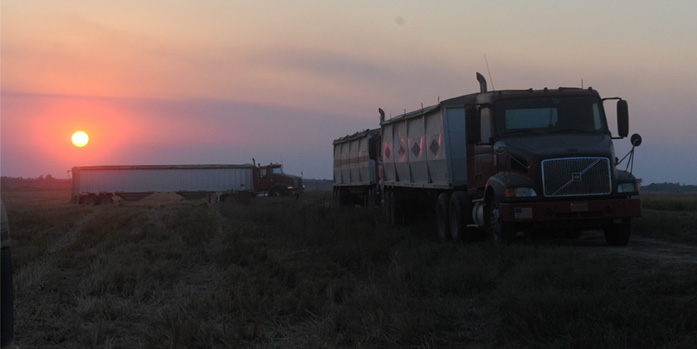 |
| Off to Branson, Missouri |
2014